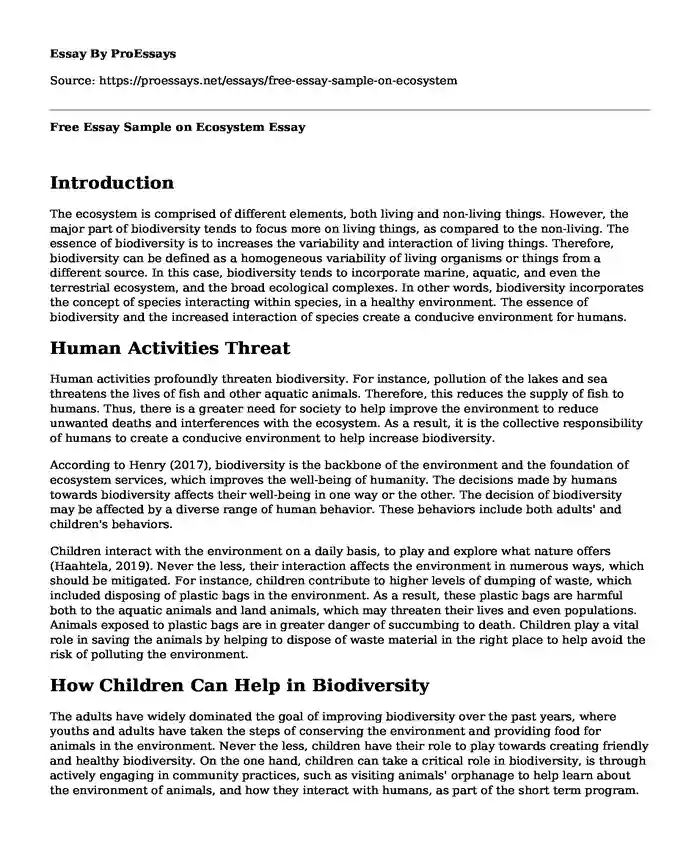Introduction
The ecosystem is comprised of different elements, both living and non-living things. However, the major part of biodiversity tends to focus more on living things, as compared to the non-living. The essence of biodiversity is to increases the variability and interaction of living things. Therefore, biodiversity can be defined as a homogeneous variability of living organisms or things from a different source. In this case, biodiversity tends to incorporate marine, aquatic, and even the terrestrial ecosystem, and the broad ecological complexes. In other words, biodiversity incorporates the concept of species interacting within species, in a healthy environment. The essence of biodiversity and the increased interaction of species create a conducive environment for humans.
Human Activities Threat
Human activities profoundly threaten biodiversity. For instance, pollution of the lakes and sea threatens the lives of fish and other aquatic animals. Therefore, this reduces the supply of fish to humans. Thus, there is a greater need for society to help improve the environment to reduce unwanted deaths and interferences with the ecosystem. As a result, it is the collective responsibility of humans to create a conducive environment to help increase biodiversity.
According to Henry (2017), biodiversity is the backbone of the environment and the foundation of ecosystem services, which improves the well-being of humanity. The decisions made by humans towards biodiversity affects their well-being in one way or the other. The decision of biodiversity may be affected by a diverse range of human behavior. These behaviors include both adults' and children's behaviors.
Children interact with the environment on a daily basis, to play and explore what nature offers (Haahtela, 2019). Never the less, their interaction affects the environment in numerous ways, which should be mitigated. For instance, children contribute to higher levels of dumping of waste, which included disposing of plastic bags in the environment. As a result, these plastic bags are harmful both to the aquatic animals and land animals, which may threaten their lives and even populations. Animals exposed to plastic bags are in greater danger of succumbing to death. Children play a vital role in saving the animals by helping to dispose of waste material in the right place to help avoid the risk of polluting the environment.
How Children Can Help in Biodiversity
The adults have widely dominated the goal of improving biodiversity over the past years, where youths and adults have taken the steps of conserving the environment and providing food for animals in the environment. Never the less, children have their role to play towards creating friendly and healthy biodiversity. On the one hand, children can take a critical role in biodiversity, is through actively engaging in community practices, such as visiting animals' orphanage to help learn about the environment of animals, and how they interact with humans, as part of the short term program. In this case, children will develop the notion of clearing about animals and their environment, rather than competing with the animals for limited resources.
Through interacting and exposing children to learn about the environment, children tend to learn about the need for conservation of the resources, such as water and proper disposal of waste products. This included the disposal of plastic bags to the right bins, which helps the plastic materials from invading and dominating in the environment.
Conclusion
To conclude, while the human population continues to increase at a rapid rate, children need to join the war in providing long-term solutions in biodiversity. Children should be integrated into the planting of trees, as one of the long-term programs that help and improve biodiversity. Therefore, children have a collective responsibility in promoting and improving biodiversity.
Reference
Haahtela, T. (2019). A biodiversity hypothesis. Allergy, 74(8), 1445-1456.
https://doi.org/10.1111/all.13763
Henry, T. J. (2017). Biodiversity of Heteroptera. Insect biodiversity: science and society, 1, 279-335. https://doi.org/10.1002/9781118945568.ch10
Cite this page
Free Essay Sample on Ecosystem. (2023, Oct 15). Retrieved from https://proessays.net/essays/free-essay-sample-on-ecosystem
If you are the original author of this essay and no longer wish to have it published on the ProEssays website, please click below to request its removal:
- Paper Example on Natural Risks
- Avoiding Outdoor Activities in Polluted Areas Paper Example
- Does College Promote Individualism or Not Essay Example
- Essay Example on Street Refuse: Composition & Sources of Pollution
- Essay Example on Online Education: Get Your Degree With Ease!
- Essay Example on Reimagining Arts & Society: The Bauhaus Model of Pedagogy
- Free Essay Sample on Deaths by Firearms: Prevalence, Injury, and Prevention







